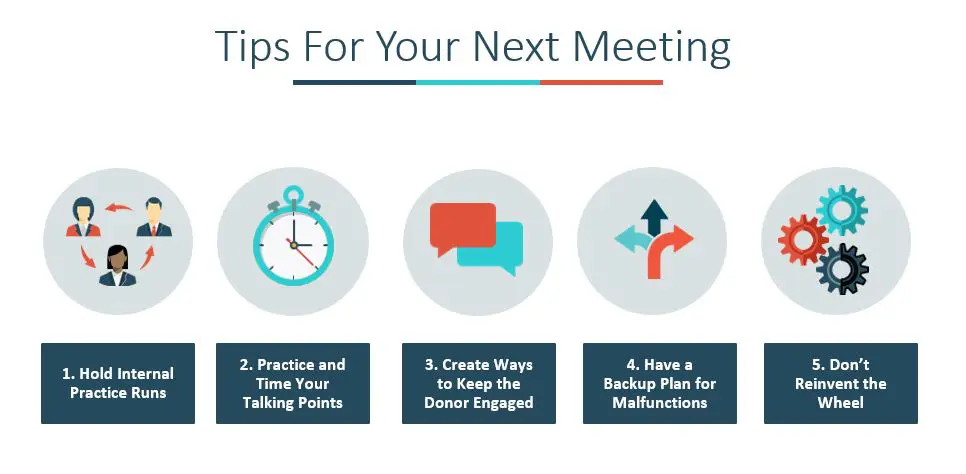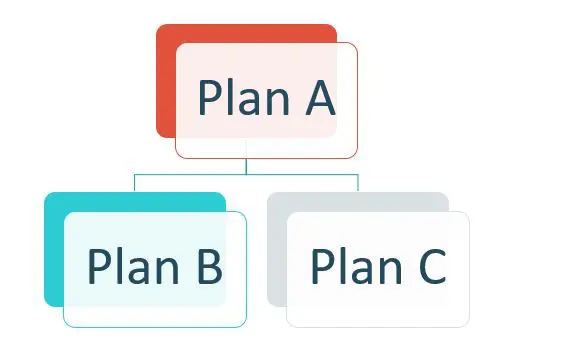The COVID-19 crisis continues to have a dramatic effect on our personal and professional lives, so out of necessity, many development teams are redirecting their focus to digital communication. As important donor meetings are moving to the video conferencing world in the coming weeks, much has been said about best practices for video conferencing in general. Tips like dressing professionally, ensuring you have the right equipment (i.e. microphones/cameras), and finding the right web platforms for your meeting are certainly useful. But how do you properly prepare to make sure that your next donor meeting is smooth and issue-free? Consider these tips in advance of your next meeting.

Hold Internal Practice Runs
To create a seamless meeting, avoiding any distractions will allow you to focus on the task at hand. You should always be logging into the meeting 15-20 minutes in advance of your session to make sure everything is running smoothly. But if time allows, you should also consider holding mock sessions with internal colleagues at least one day in advance of your meeting. You can utilize this practice time to:
- Determine Roles: Divvy up responsibilities on your team where everyone plays a part. If you are using webinar software and inviting multiple people to the conversation, give your teammates official roles on the backend (i.e. organizer, panelist, attendee, etc.) so you can test what each view looks like.
- Avoid Technical Issues: Doing a dry run will help you work out any technical kinks that may arise. It will also help you get up to speed on the format and functionality of the software. Testing your internet connection, microphone/phone/computer audio, as well as your web camera and room lighting during these practice runs will allow you to enter the real meeting with confidence that things will look right and operate correctly.
Practice and Time Your Talking Points
It is essential that you avoid going over time in your pitch or presentation. Planning talking points is even more important when using digital platforms. Use the internal practice runs to time things out so you have a better understanding of what to add or cut down for the meeting. Consider also having a colleague act as the donor and ask potential questions so you can time out your answers accordingly. Creating and communicating a detailed agenda well in advance will also go a long way to establishing expectations.
In creating your timeline, make sure you plan for the first five minutes to be used for everyone to sign in and get acclimated to the software. It is also important to leave time for introductions and small talk to keep the conversation personable. For example, it is natural that your donor may want to briefly discuss the COVID-19 crisis and how it is affecting them, and it’s important to allow time for this very important issue to be addressed. By being prepared, you can avoid letting this topic monopolize the agenda. You should also allow for time in case there are any technical issues, such as the donor’s internet connection or phone dropping out temporarily. This way you won’t feel rushed at the end of your meeting.
Create Ways to Keep the Donor Engaged
Keeping your audience engaged throughout is key to ensuring that the meeting is productive for everyone involved. After introductions and preliminary discussions, transition the conversation to an overview of the key points on the agenda. While you want this to stay as structured as possible, tell the donor that you welcome questions throughout to keep the conversation flowing freely. This will also help you gauge what is resonating. There could be multiple people on the call who are not all easily seen on screen, which could make it more difficult to read body language and respond to visual cues. Stopping to ask questions of the donor will go a long way in eliminating those issues.
Additionally, utilizing the technology to incorporate visuals and downloadable documents will allow for richer discussions. These should also be prepared and shared prior to the meeting. On a recent virtual donor session, leaders of a small parish in Connecticut were meeting with an elderly donor through a video conferencing platform. Three days before the meeting, the team sent e-mails to the donor with links to download the software as well as all meeting materials which included the case for support, an FAQ document, and a detailed meeting agenda. This allowed the leaders of the parish to focus more on the conversation and during the meeting itself, they didn’t need to take any time out of the discussion for materials to download. If possible and if time allows, mailing the donor hardcopy documents well before the meeting day adds another element of personability to the session.
Have a Backup Plan for Malfunctions

Because so many professionals are now using digital platforms to hold meetings, even the best programs are seeing technical issues due to bandwidth challenges. It is therefore worthwhile to have backup programs ready to use should your primary platform have technical issues.
In a recent meeting, leaders at an independent school were using video conferencing software to follow up with an important alumni donor and share campaign plans in light of the COVID-19 crisis. The software worked smoothly during the practice run a day before, but when members of the development team logged in 20 minutes before the meeting to test the software, the screen kept freezing and the screenshare function wasn’t working properly. After not being able to solve the issue in short time, the team quickly pivoted and decided to move to a different platform. They logged into the backup platform, sent the donor an email with new login instructions, and were able to hold a successful issue-free meeting that began on time.
As a third backup option, you can always consider moving to an audio-only conference call. Having these options in your back pocket will prepare you for any curve balls thrown your way and will keep you from needing to postpone the meeting.
Don’t Reinvent the Wheel
It is important to remember that even with meetings being moved to the digital space, the principles and best practices of how you communicate with donors remain the same. Articulate your mission with clarity and confidence and continue to find ways to provide meaningful follow-up correspondence after your meeting. This includes new and expanded materials that reflect what was discussed during the meeting.
Most importantly: thank the donor for their time both on the call and in your follow-up calls/e-mails. The commitment they made during this time of heightened uncertainty can’t be understated, and the donor should feel your appreciation in every step of the process.
Additional Resources for Video Conferencing Best Practices
- Stanford University – Best Practices for Effective Video Conferencing
- University of Washington – Video Conferencing Best Practices
- Harvard Business Review – What It Takes to Run a Great Virtual Meeting
- University of San Diego – Best Practices for Effective Video Conferencing
- IMPACT – 14 Ways to Impress on Your Next Video Conferencing Call
- Flexjobs – 10 Best Practices for Video Meetings
- Big Duck – Facilitating Great Meetings Online
During this challenging time, we are continuing to offer our perspectives and lessons learned from over seven decades of nonprofit advisory leadership. Click here to access our Strategies During COVID-19 page. Here you will find resources that provide best practices and optimal strategies to help your organization build a path through this crisis and beyond.
CCS Fundraising is a strategic fundraising consulting firm that partners with nonprofits for transformational change. Members of the CCS team are highly experienced and knowledgeable across sectors, disciplines, and regions. With offices throughout the United States and the world, our unique, customized approach provides each client with an embedded team member for the duration of the engagement. To access our full suite of perspectives, publications, and reports, visit our insights page. To learn more about CCS Fundraising’s suite of services, click here.